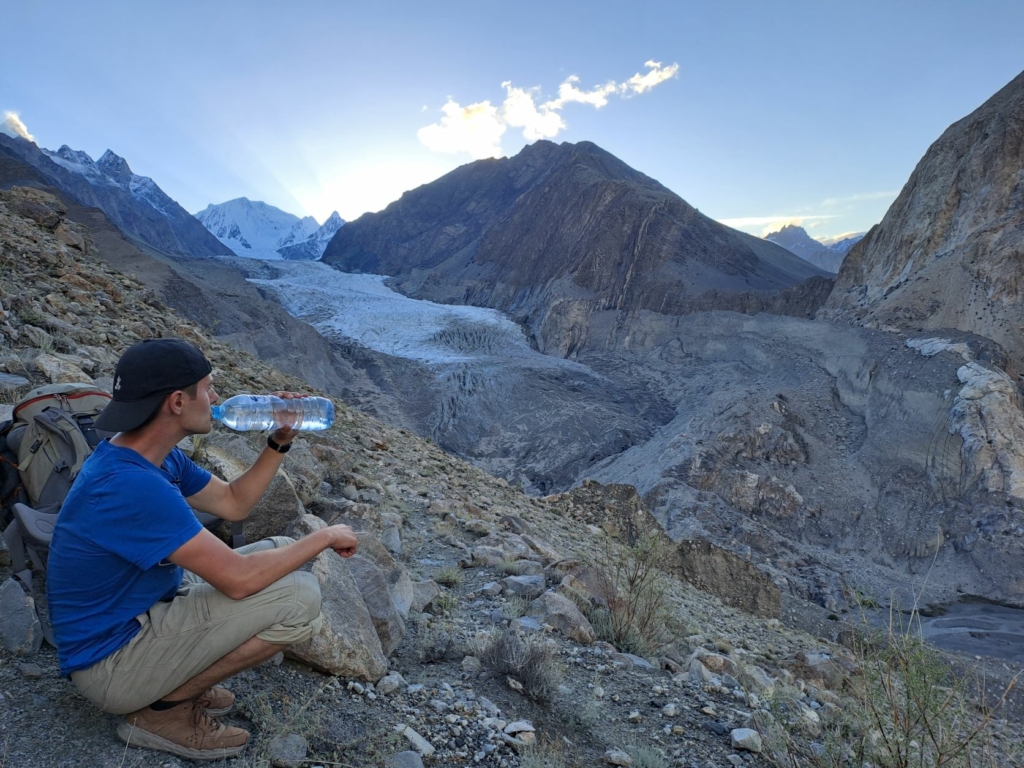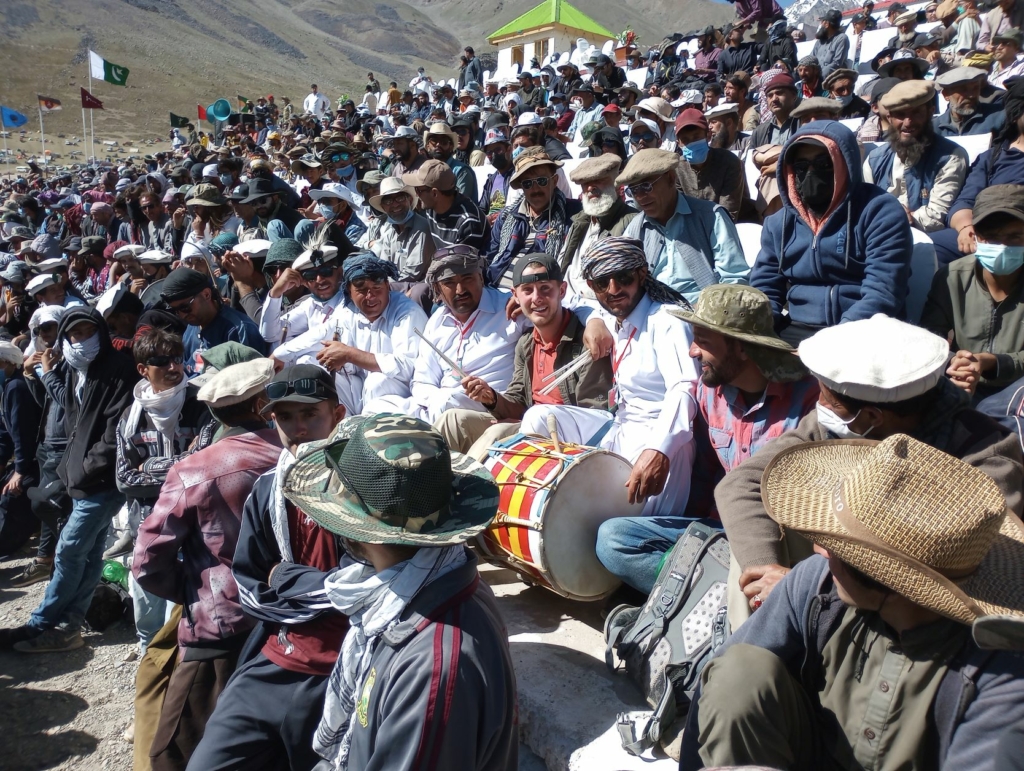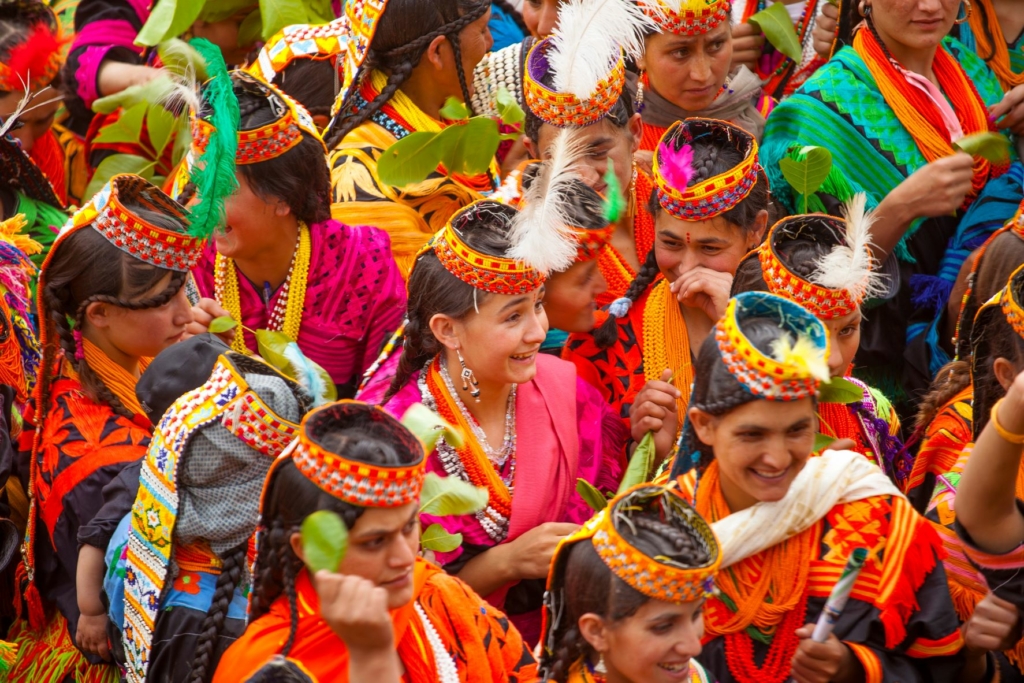Pakistan is home to over 7,000 glaciers scattered across numerous mountain ranges of the Northern region villages. Previously before coming to Pakistan, I assumed the region was an empty desert desolate with endless sand dunes. Upon arrival, expectations of Pakistan changed entirely as it is home to 108 peaks above 7,000 meters and more glaciers than anywhere else on Earth outside the poles. The countless glaciers captured my attention for the serene natural sceneries and the impact these glaciers have on the people living around them. My expedition set out North of Hunza Valley towards the colossal Passu Glacier trek. A weekend encompassed by the idyllic views of the Passu Cones, Passu Peak, and the Passu Glacier Trek soon became the trip of a lifetime.
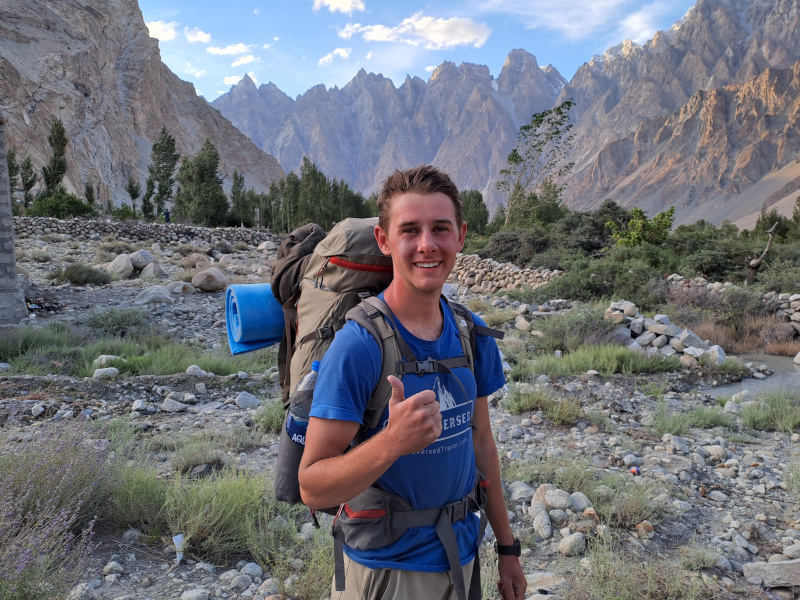
Introduction to The Passu Glacier Trek
Our road trip began on the Karakoram Highway as we traveled to Passu Village at the bottom of the Glacier. Our journey was three nights of camping from the shores of the Gilgit River next to the Passu Bridge to the flourishing meadows up to the Passu Glacier. The more traditional trek route ranges from a short few hours walk to a multi-day expedition up to Passu’s Peak. Hiking to the glacier outlook reveals a small, scenic café serving french fries, barbeque, and hot chai upon request. This petite café doubles as the hub for tour guides, maps, and a scenic outlook over the Passu valley.
The route taken to this quaint café determines the duration of the trek to view the epic glacier. Taking a car or private jeep up to this point cuts down the hiking time to a leisure 30-minutes. Starting at the trailhead to the Passu Glacier trek offers a more scenic path through the valleys lasting only a few hours. The alternative route is simply to hike a further expedition led by a tour guide up to the top of Passu Peak. Along the way, surprisingly stands a lush green meadow filled with untamed wildlife and numerous plant species to camp on the first night. The second day crosses over the precipes of the glacier itself with crevices as deep as hundreds of feet. The second night is spent in a secluded utopia of a meadow known as Patundas Top beyond the glaciers or continue the journey to the top of the glacier, whichever the body can handle!
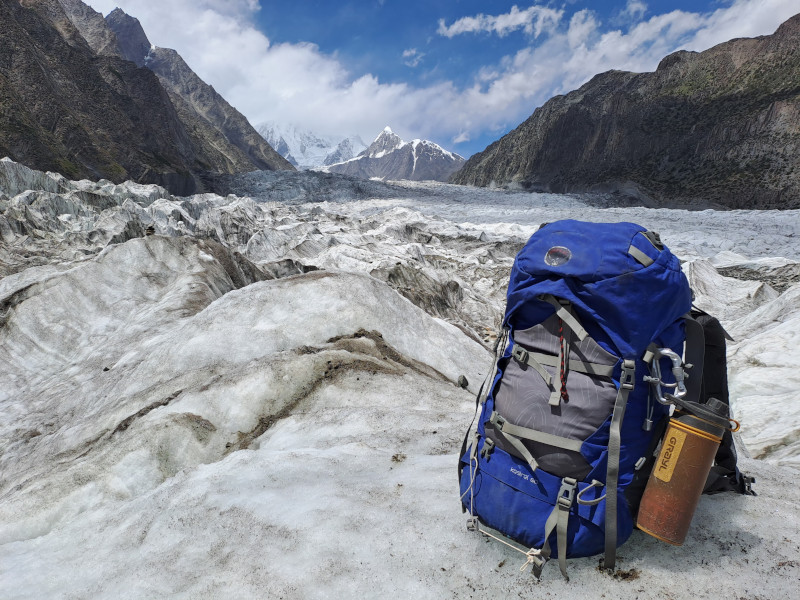
The Best Route to see Everything
The best route to truly be immersed in the surrounding natural attractions starts off on the Karakoram Highway to the scenic shores of Borith Lake. In the mountain village of upper Hunza, the serene lake views create a serene environment to experience a moment away from the prying world. After the picturesque jeep ride and viewing sights, refresh yourself with local cuisine and other amenities at the restaurant and lodge by the edge of the lake. If you are lucky enough to visit anywhere from March to June, the area is famous for the migration of Siberian ducks and many bird species. Reach this village via a picturesque private jeep ride from the Hussaini Village and upwards from the trailhead.
The two-hour scenic drive through the Passu Valleys lands at the base of the trail up to the Passu Glacier trek known as Zero Point. This is the quant café serving amazing chai, which is hot black tea mixed with milk and sugar (the best drink in Pakistan). From this point forward a quick 30-minute walk scaling up the trail reaches the best-unobstructed view of the Passu Glacier.

The glaciers often make spontaneous booming sounds from the inner parts of the glacier breaking apart in the warm summer weather. Regardless of summer sunshine, the area fluctuates temperatures and weather drastically depending on the breeze coming off of the freezing glacier. One moment may be hot outside the peripherals of the glacier and rapidly shift to freezing weather. The descending river waters from the melting glaciers bring a refreshing cool breeze throughout the valley. Dressing in multiple layers is the best way to prepare for the temperatures by adding or losing any layers to accommodate the volatile weather conditions.
Our Journey
We tackled the expedition up to Passu Glacier a little differently from the traditional route. Beginning in the heart of Passu Village, we stocked up on the best camping foods like ramen noodles, cakes, biscuits, chocolate, and even ingredients to make our own chai! We chose to start our three-night camping trip at the lowest elevation possible. Our first trip was from Passu Village to the Passu Bridge journeying through the local fruit farms growing apples, apricots, and corn. Coming up to the Karakoram Highway was a breathtaking view of the Passu Cones neighboring a straight outlook up to Passu Peak. Truly, one of the most surreal sights in Northern Pakistan especially at sunset illuminating the golden wafer Passu Cones.
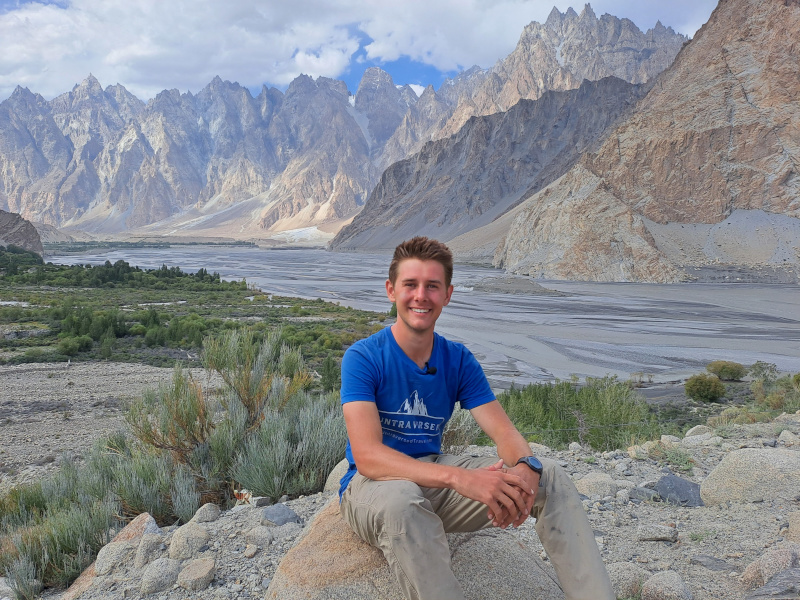
After an hour through the local farms and forest, we arrive at the Passu Bridge around sunset. A flat and beautiful sand plateau rested about 10 feet from the trail across still water about a foot deep so we decided to camp there. In the late evening, the moon shined through the singular opening in the surrounding mountain ranges paired with the ambient sound of crickets chirping in the swamp over the still lagoon. While finishing off our ramen noodles and sipping chai, the stars overtook the night sky and set the scene of the most tranquil surroundings of my life.
Crossing the Passu Bridge
The next morning, our sights were set to cross one of the most significant and dangerous bridges in the world; the Passu Suspension Bridge. This bridge sits over the rushing waters of the Hunza River held up by seven cables with various-sized planks of wood sitting freely each step of the way. The insecure steps can even sit entire feet apart accumulating a total distance of 64 meters or about 400 steps.
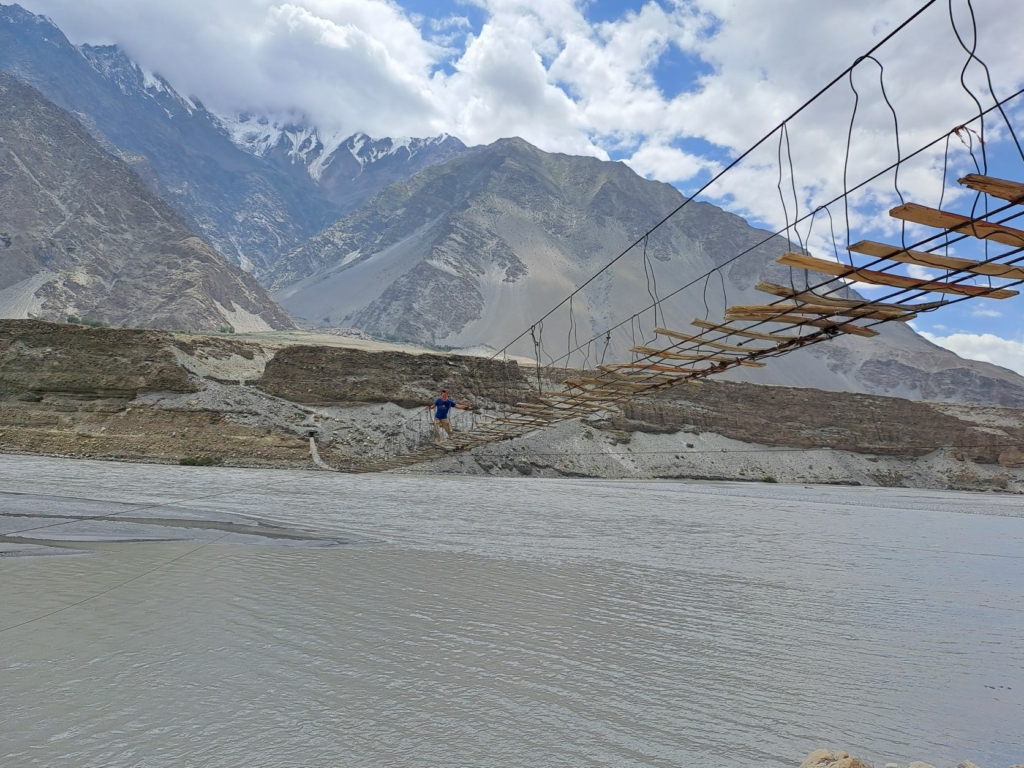
The bridge is crossed daily by domestic villagers living on the other side of the bridge who live as nomadic shepherds. We carefully crossed the rickety bridge, but since there is not too much to explore on the other side, we quickly left to start the next leg of our journey.
Result of the Melting Glaciers
The morning was still early arriving at the “Welcome to Passu” sign and we soon continued on the rocky path to the Zero Point trailhead arriving a few hours later. At the site, we met an extremely accommodating tour guide to join and lead us to our first campsite in the lush meadows ahead. Hiking through the curvy shale stone paths, we arrive at the first outlook over the glacier next to shepherd huts made out of stacked slate-like stones to block the wind. The shepherd’s hut was a tempting place to camp but we kept going for the pot of gold at the end of the rainbow in the green plains of Passu Glacier.
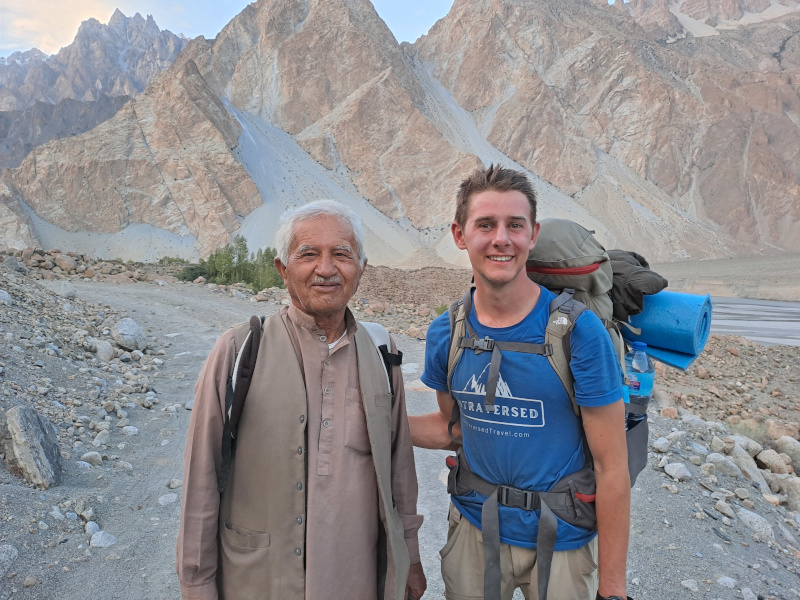
As we carried on up the steep path overlooking the glacier, our guide shared stories of the rapidly receding glacier line over the past years. The monumental impact on local villages of the melting glaciers could not be witnessed in a simple day or two. He shared stories of several bridges built with the durability of ten years being completely washed away by powerful floods and landslides. This case example was the ruination of the concrete Hassanabad bridge built high above the waters.
Turns out the country has been recently experiencing earlier, hotter, and more frequent heatwaves reaching temperatures up to 50°C (122℉). This may seem trivial to have occasional hot weather, however, with Pakistani’s dense population of glaciers, warmer temperatures mean dangerously high levels of melting glacier runoff. The melting glaciers displace large bodies of water throughout various mountain ranges including 33 lakes labeled as high risk for bursting.
Making a Greater Impact
Observing the glaciers cracking and booming under heat showed me the critical role we have in preserving the glaciers for clean drinking water and reducing the risk of natural disasters. As I reflected, my trek up to the Passu Glacier and Pakistan was more than simply showcasing iconic natural attractions. It was about being a part of a greater purpose to support local villages that are suffering from the consequences of our rapidly changing environment.
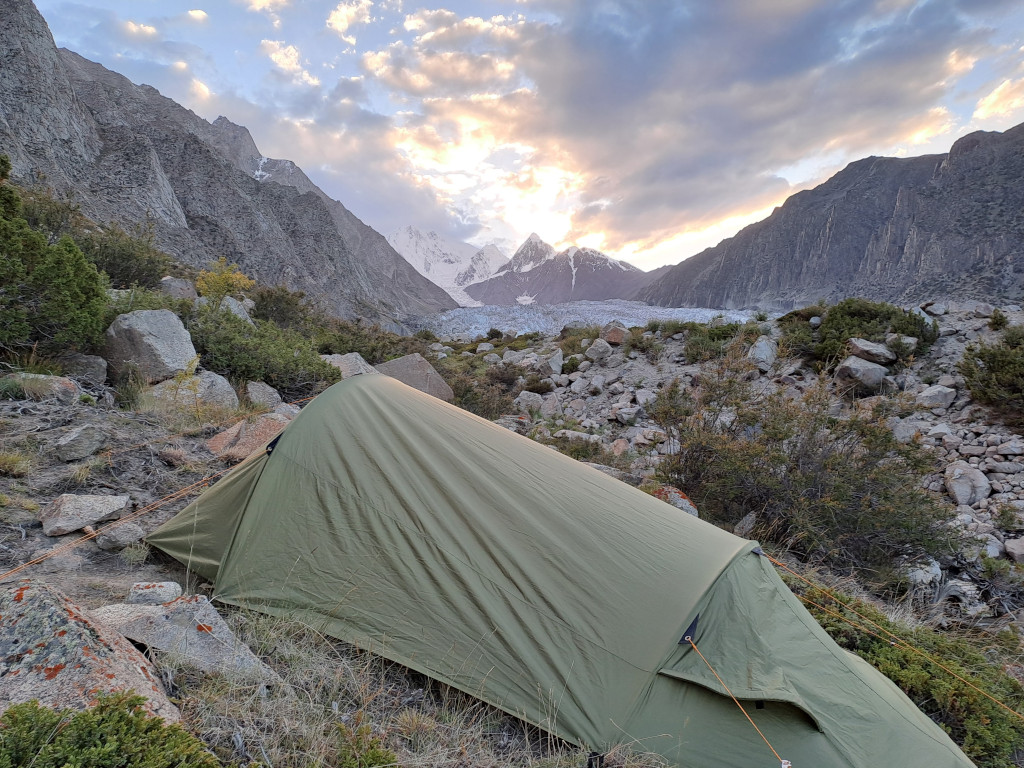
After sharing many stories of each other’s lives and gawking at the idyllic valleys, our environment transformed from a desolate rocky area to a thriving grassland flowing with streaks of water. In a mere few hours, it felt like I had traveled to a different country experiencing two completely different sceneries. We set the campsite up for the night with macaroni and cheese accompanied by chai on the menu for dinner. As we set up our tent and stuffed our bellies, we talked for hours laying on our backs staring at the ocean of stars lighting up the sky. The next morning, we trekked over the epic cavernous glacier appearing white as snow drizzled with chocolate-colored lines of sediment over the tops. The tour guide led us over the cairn-marked paths and took us back to base camp where we enjoyed chai and said our goodbyes.
Conclusion
If you are fortunate enough to experience the Passu Glacier trek, the astounding number of natural landmarks will take your breath away. This life-changing journey changed my perspective of the diverse landscape surrounding Pakistan glaciers and the impact they have on the local villages. Taking a tour up to the Patunda Top meadows shows the striking beauty of the quickly changing landscapes up towards the ridge of the Passu Glacier. Hearing the locals’ stories, grew compassion in my heart for traveling to majestic national landmarks and supporting the local economy to sustain the push back against rising temperatures globally. Adventure is calling to explore the immense Pakistani glaciers and invigorating mountain ranges. If you want to discover these extraordinary sights for yourself, Untraversed Travel makes full itineraries for the trip of a lifetime touring across the mountains of Northern Pakistan. To learn more about how you can be a part of experiencing the Passu Glacier, be sure to check out our Karakoram Highway Adventure.
